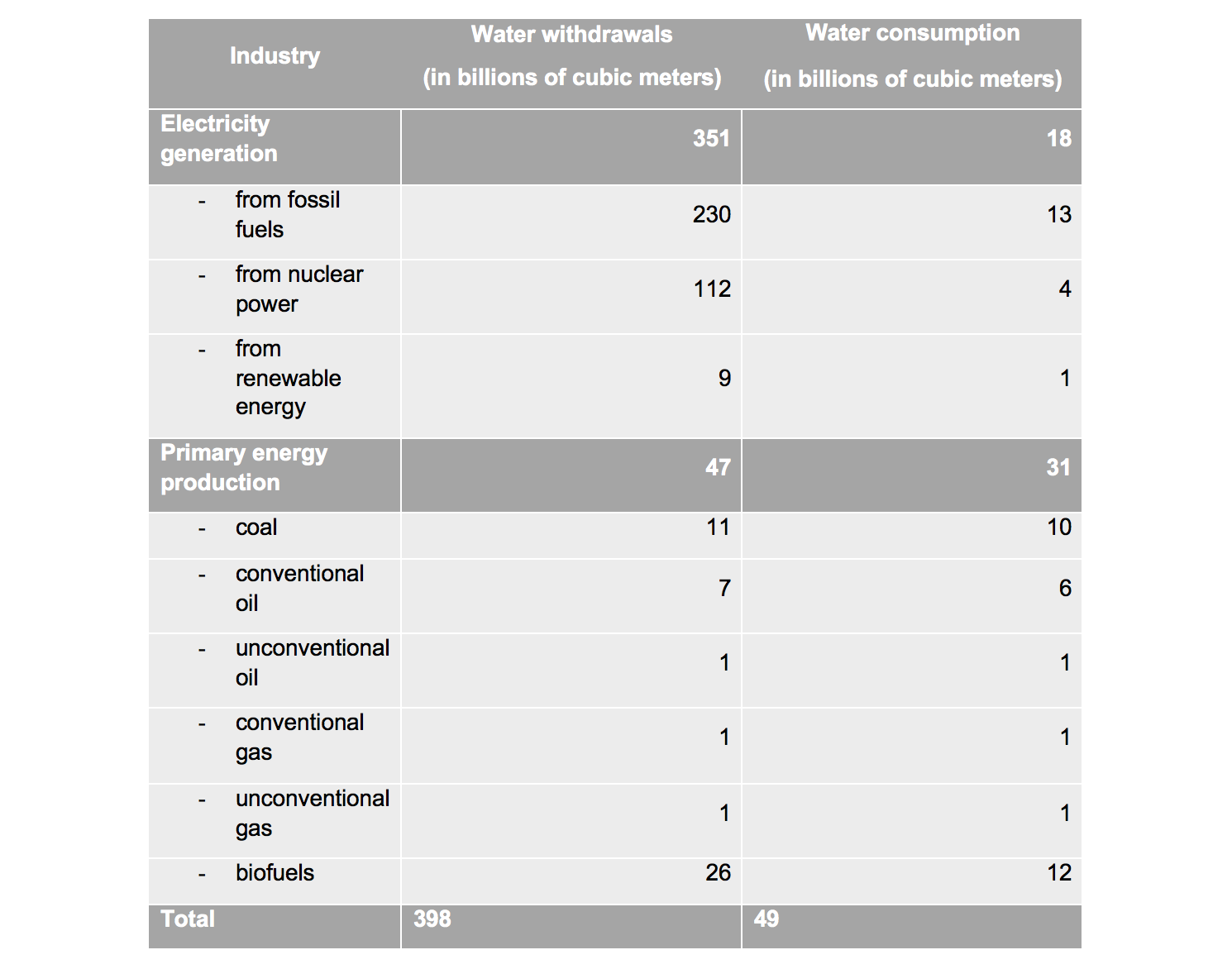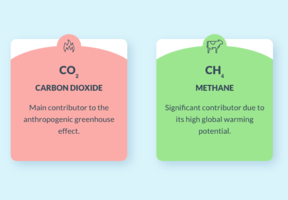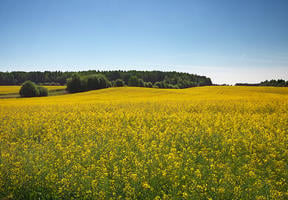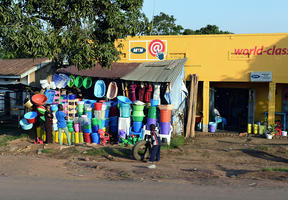Energy and Water Are Closely Intertwined
Published on 09.26.201810 min read
Water is a vital resource for the majority of energy industries, used in generation (to cool down plants), fossil extraction and oil refining, but also for the irrigation of crops grown to produce biofuels. Finding a way to manage this water sustainably is essential at a time when the world’s water resources are already under increasing stress due to population growth and .

© ANDREW BURTON / GETTY IMAGES NORTH AMERICA / AFP - Water is a vital resource in drilling for oil. The photo shows a shale oil extraction site in Watford City, North Dakota (United States).
Distinction Between Withdrawal and Consumption
Humans withdraw vast quantities of water for various purposes. The majority of this water (two-thirds of the total) is used by agriculture. Next come drinking water and water for industrial operations. As estimated by the , energy‑related activities require 10% of the total volume of water used by humans. But this proportion is set to increase between now and 2040.
When talking about water, it is important to understand the difference between “withdrawal” and “consumption”.
In the first case, water is withdrawn from a natural source and then released back into that source either without treatment, after being used for cooling at a power plant, for example, or with treatment, if the water quality has been affected.
In the second, water is withdrawn from a natural source and released into another source. For example, water from a river is diverted into a pool from which it evaporates, or is injected into the ground without being recovered. Consumed water is not returned to its original natural source.
However, certain processes actually result in the production of water, such as oil and gas extraction in which water present in subsurface formations is brought to the surface. The volume of “produced water” is typically greater than that of the oil or gas recovered.
The difference between the volumes of water withdrawn and consumed varies widely depending on the industry.
For example, producing electricity from fossil fuels or nuclear power requires massive quantities of water to be withdrawn: 342 billion cubic meters in 2014, of which 325 billion were returned to the natural source. The difference is mainly due to evaporation.
The production of sources ( , oil, gas, biofuels) requires less water (47 billion cubic meters) but returns very little (16 billion cubic meters). Overall, primary energy production can thus be said to “consume” a higher proportion of water than power generation.
How Is the Water Used?
Hydro: Hydropower plants neither withdraw nor consume water, save for evaporation from barrier lakes. They extract energy from the water flowing through them, without altering it.
: Hot water from deep aquifers is used to produce steam. Once cooled, the water is reinjected into the ground, making geothermal a closed loop system with relatively little water loss.
Thermal: Thermal power plants need water to cool the steam that drives the turbines generating the electricity.
Nuclear plants withdraw the most water, from rivers or the sea. Water is kept in a secondary circuit isolated from the reactor and is returned to nature after being cooled to a temperature that will not affect the ecosystem.
As by far the most common type of power plant worldwide, coal-fired plants are those that use the most water.
Concentrated solar power plants, which use parabolic troughs to capture from the sun, are also water-intensive, which is problematic as they are often located in arid or semi-arid regions.
Wind and photovoltaic: These two industries consume very little water, save for that required to produce solar cells, which must be washed using ultra-pure water, generally flowing in a closed system.
Biofuels: As they are plant-based, producing biofuels requires large quantities of water for irrigation purposes. In 2014, biofuels represented one-quarter of the water consumed for energy production, outdoing coal and oil, and far surpassing gas (see box).
What About Oil and Gas?
The oil and gas industries use water at different stages in their processes, especially during well . However, the production process itself is particularly water-intensive. When the pressure in well. If the pressure falls, the operators inject water into (or “flood”) the reservoir to push the oil or gas toward the surface from underneath.
Over time, the oil field passes its peak or “matures”, and produces both oil and water, the latter coming from the reservoir itself and from the flooding. On a global average, an oil well produces one of oil for three barrels of water, but a mature well can produce as much as ten barrels of water for one barrel of oil. Certain oil companies even specialize in managing end-of-life fields, which can produce up to 96% water!
Taken from rivers or aquifers for operations or directly from the sea for platforms, flood water must be treated before it can be injected. The sulfates must be filtered out, as they could affect the permeability of the reservoir, and oxygen must be removed to prevent and the growth of . The fluid recovered from the well, known as “produced water”, takes the form of an emulsion of water droplets in oil and is of very poor quality, often corrosive. It must be treated before being reinjected into the ground or discharged into the natural environment1.
Shale Gas and Oil Sands
, or “fracking”, is a process used to recover and gas that requires large quantities of water in its early stages. A high-pressure of water is used to create cracks in the source rock to release methane. The water flows through the , mixing with the groundwater, and can be partly recovered. Although extremely water‑intensive at the outset, the process’s requirements subsequently dwindle.
For producers, the challenge lies in managing the large tailings ponds into which the water used to wash the sands is deposited. More than 90% of the water can be recycled but the ponds take decades to dry up, leaving the non-volatile content behind. These sometimes massive structures can have an impact on local ecosystems.
Downstream Operations: Refining
Refineries need water for the initial processing of , steam production and cooling circuits. Process water is treated using physical and chemical processes, such as settling and , or biological methods, which use microorganisms to consume the dissolved hydrocarbons. Major savings have been made in terms of the quantity of water used in the industry: according to IFP Énergies Nouvelles (IFPEN), the average consumption of a refinery has fallen from several cubic meters per metric ton of crude in the 1980s to between 200 and 800 liters per metric ton today.
Water Withdrawal and Consumption Statistics (2014)

Source IEA
Water Withdrawal and Consumption Statistics
The energy sector is responsible for 10% of global water withdrawals. However, given the rate at which water is returned to the natural environment, energy-related consumption represents just 3% of the total.
In France, nearly 60% of water withdrawals are used to cool power plants, especially nuclear plants. The remainder is used for drinking water and domestic use (18%), irrigation (15%) and industry (9%).
Sources:
- Oil and gas companies have formed an association for analyzing and reducing the environmental impacts of their activities, known as IPIECA.



















